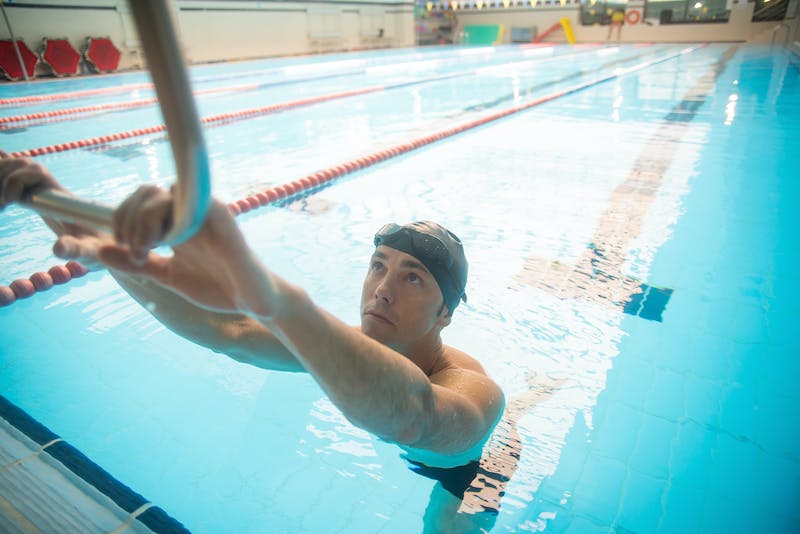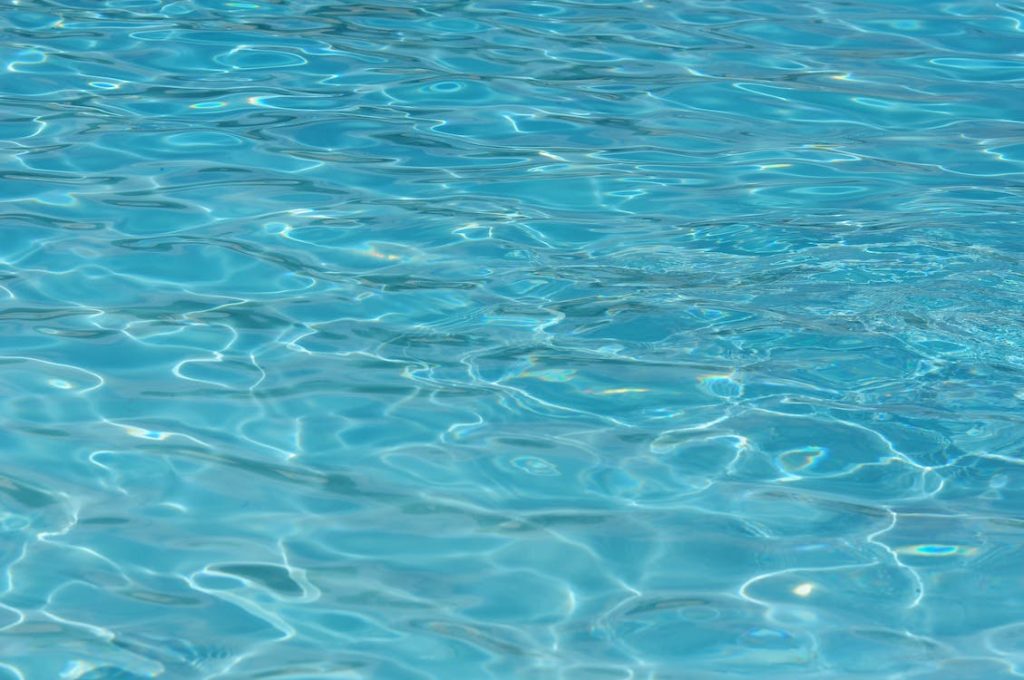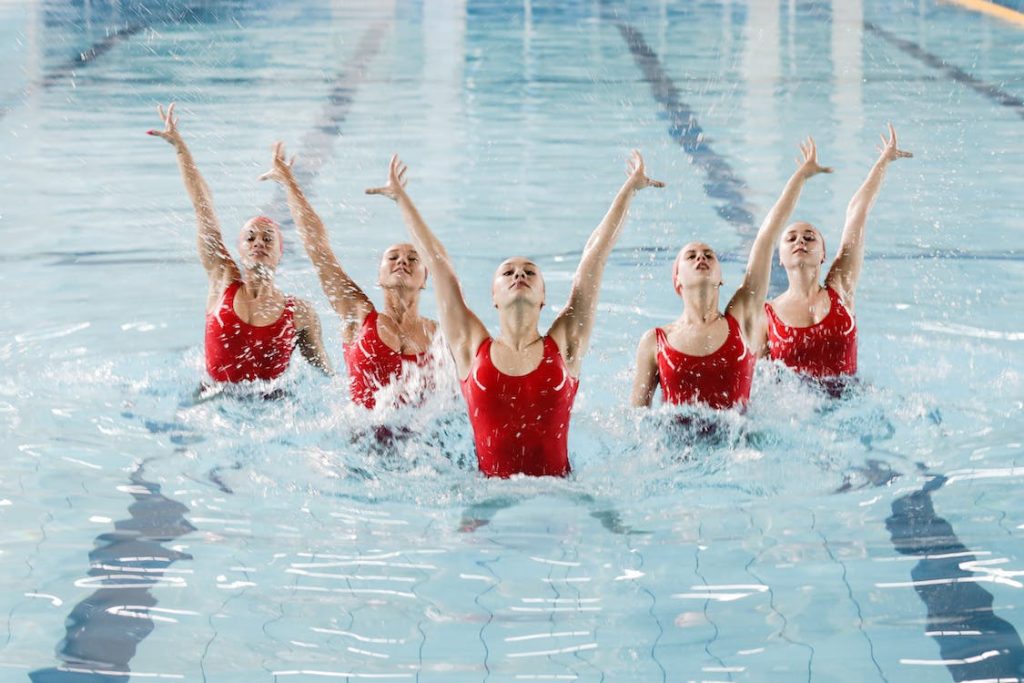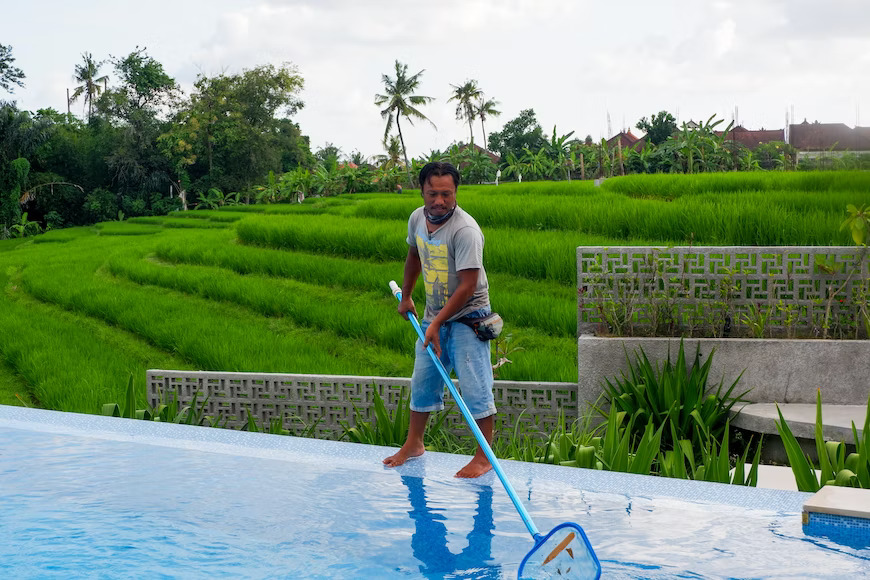Swimming is a well loved sport enjoyed by millions of people around the world. Whether for competitive swimming or leisurely laps, swimming pools are a hub of activity and relaxation.
Among the essential components of maintaining a clean and safe swimming environment is the use of swimming pool chlorine.
Chlorine has long been regarded as a standard disinfectant for swimming pools, keeping harmful bacteria, germs, and contaminants far away from the pool water.
However, over the years, numerous misconceptions and myths have surrounded the use of chlorine in swimming pools.
In this blog post, we will explore 10 shocking lies about swimming pool chlorine and shed light on the truth behind these claims.
We will also explore the benefits and disadvantages of swimming pool chlorine in the swimming sport, and swimming pool chlorine dos and don’ts for pool owners.
Why is Chlorine Important for Your Swimming Pool?
Chlorine is not just an ordinary chemical; it’s an element that maintains the health and hygiene of your swimming pool.
Acting as a powerful disinfectant, chlorine serves as a shield against harmful bacteria, viruses, germs, and other contaminants that could otherwise turn your pool into a breeding ground for waterborne illnesses.

Its ability to neutralize and eliminate these potential threats is unmatched, making it a vital element for any responsible pool owner.
How Swimming Pool Chlorine Keeps Swimmers Safe
Imagine a pool without chlorine- that is a paradise for harmful bacteria to grow. But thanks to the swimming pool chlorine, you can swim with confidence, knowing that the water you’re diving into is as clean and safe as can be.
Here’s how chlorine works its magic:
-
Bacteria and Pathogen Elimination: When chlorine is added to pool water, it releases hypochlorous acid, a potent disinfectant.
This acid gets to work immediately, attacking and destroying bacteria, viruses, and other harmful pathogens that might be lurking in the water. -
Algae Prevention: Apart from keeping the water free from dangerous microorganisms, chlorine also plays a crucial role in preventing algae growth.
Algae can turn your pool into a slippery, slimy mess, but with a proper chlorine balance, you can maintain the crystal-clear allure of your pool. -
Oxidizing Contaminants: Not only does chlorine destroy harmful microorganisms, but it also acts as an oxidizer.
This means it breaks down and eliminates various contaminants like body oils, sweat, and other organic matter introduced by swimmers, leaving the water fresh and clear. -
Continuous Disinfection: One of the fantastic properties of chlorine is its ability to offer continuous disinfection.
Once you’ve achieved the right chlorine levels, it works diligently to maintain the water’s cleanliness and safety, safeguarding your pool day and night till the pool water is changed.
Debunking the Lies About Swimming Pool Chlorine
- Chlorine Causes Red Eyes and Skin Irritation:
One of the most common misconceptions about swimming pool chlorine is that it is the primary cause of red eyes and skin irritation in swimmers.
However, the truth is that chlorine itself is not the one responsible for red eyes and skin irritation in swimmers.
Red eyes and skin irritation are the result of chloramines, which are formed when chlorine reacts with sweat, urine, and other organic matter brought into the pool by swimmers.
Chloramines are irritants that can cause eye and skin discomfort. To minimize chloramines, maintaining proper pool chemistry and hygiene, such as showering before entering the pool, can significantly reduce these symptoms.
Chlorine, in its pure form, is not harmful to the skin or eyes. In fact, it has been used for decades to disinfect water and make it safe for swimming.
The discomfort experienced by swimmers is due to the presence of chloramines, not the chlorine itself.
Chloramines can be kept in check by regularly monitoring and maintaining proper chlorine levels in the pool.
- Chlorine Turns Hair Green:
Another widely circulated lie is that chlorine causes swimmers’ hair to turn green.
While green hair is indeed a common occurrence among swimmers, it is not directly caused by chlorine.
Instead, copper compounds found in some pool water or plumbing systems are responsible for the greenish tint.
These copper compounds can get into the pool water from various sources, such as rusty pipes or algaecides containing copper.
It’s essential to note that the green tint is not harmful and can be easily treated with clarifying shampoos.
Regularly washing hair with fresh water and using protective products before swimming can also help prevent green hair.
- Chlorine Has a Strong Odor:
The distinct “chlorine smell” often associated with swimming pools is not actually the smell of the swimming pool chlorine itself but of chloramines.
When chlorine reacts with contaminants in the water, it forms chloramines, which emit a potent odor.

A well-maintained pool with proper chlorine levels will have a minimal chlorine smell, indicating that the pool water is clean and safe for swimming.
The strong smell of chloramines is often a sign that the pool water is not adequately sanitized.
This can happen when there is an excessive amount of organic matter, such as sweat, urine, and other bodily fluids, in the pool water.
Regularly monitoring and maintaining chlorine levels, along with proper filtration and water circulation, can help prevent the buildup of chloramines and minimize the unpleasant odor.
- Chlorine Is Harmful to Your Health:
There is a widespread belief that swimming in chlorinated water poses significant health risks.
While exposure to high levels of chlorine gas can be hazardous, the diluted levels of chlorine used in swimming pools are generally safe for swimmers.
In fact, chlorine is crucial in preventing the spread of waterborne illnesses and maintaining water quality.
Chlorine has been used for decades as a disinfectant in drinking water and swimming pools, and extensive research has been conducted on its safety.
The Centers for Disease Control and Prevention (CDC) and the World Health Organization (WHO) have established guidelines for safe chlorine levels in swimming pools to ensure the health and safety of swimmers.
Swimming pool water is continuously treated and monitored to maintain optimal chlorine levels.
When chlorine is properly used and maintained within the recommended range, it effectively kills harmful bacteria, viruses, and parasites that can cause waterborne diseases.
However, it is essential to handle chlorine with care and avoid direct contact with concentrated chlorine products, as they can cause skin and eye irritation.
- Chlorine Is the Only Option for Pool Disinfection:
Contrary to popular belief, chlorine is not the only option for pool disinfection. While it is the most widely used and cost-effective method, there are alternatives such as bromine, ozone, and UV systems.
Each of these methods has its pros and cons, and some may be more suitable for specific pool types or preferences.
Bromine is another effective disinfectant commonly used in hot tubs and spas. It is more stable than chlorine in high-temperature water and is an excellent alternative for those who may be sensitive to chlorine.
Ozone and UV systems are advanced methods of pool sanitation that can reduce the reliance on chlorine.
Ozone systems produce ozone gas, which is a powerful oxidizer and disinfectant, while UV systems use ultraviolet light to kill bacteria and viruses.
It’s important to note that while these alternatives can reduce the amount of chlorine needed, they may not completely eliminate the use of chlorine in pool water.
Combining multiple pool sanitization methods can provide a more comprehensive and balanced approach to pool maintenance.
- Chlorine Can Be Replaced by Saltwater Systems:
A common misconception is that saltwater pools are entirely chlorine-free. In reality, saltwater pools use a chlorine generator that converts salt into chlorine through a process called electrolysis.
While the chlorine levels in saltwater pools are generally lower and may be less irritating to the skin and eyes, they still contain chlorine.

Saltwater systems can be a viable option for some pool owners, but it’s essential to recognize that they still rely on chlorine as the primary disinfectant.
The advantage of a saltwater system is that it generates chlorine as needed, providing a more consistent and stable level of chlorine in the pool water.
This can result in a more comfortable swimming experience for some individuals compared to the traditional swimming pool chlorine usage methods.
Pool owners must understand that maintaining a saltwater pool still requires regular monitoring and adjustment of chlorine levels to ensure proper sanitation.
Additionally, the salt used in the system needs to be periodically refilled, and the pool’s pH levels must be balanced to avoid any potential damage to pool equipment and surfaces.
- Chlorine Is a Carcinogen:
A carcinogen is a substance that can cause cancer in the human body.
There have been concerns about the potential cancer-causing properties of chlorine and its by-products. However, when used appropriately, chlorine is not considered a carcinogen.
Studies have shown that the risk of cancer from swimming pool exposure to chlorine and its by-products is minimal compared to other everyday environmental risks.
Chlorine by-products, such as trihalomethanes (THMs), are formed when chlorine reacts with organic matter in the water.
THMs are a group of chemicals that can be found in small amounts in chlorinated water. Research on the potential health effects of THMs has yielded mixed results.
While some studies suggest a possible association between high THM exposure and certain cancers, the evidence is not conclusive.
To minimize the formation of THMs, pool owners can take measures to reduce the amount of organic matter in the water.
This includes maintaining proper chlorine levels, ensuring good pool circulation and filtration, and encouraging swimmers to practice good hygiene before entering the pool.
- Chlorine Is Harmful to the Environment:
While chlorine is a potent chemical, its impact on the environment is highly dependent on how it is used and handled.
When discharged into the environment in large quantities, chlorine can be harmful. However, responsible pool management, including proper water treatment and disposal practices, can minimize chlorine’s environmental impact.
Chlorine should never be directly discharged into natural water bodies without proper treatment, as it can harm aquatic life and disrupt the ecosystem.
Instead, pool water should be dechlorinated and treated before being released into the environment or used for irrigation purposes.
Advancements in pool technology have led to the development of more eco-friendly pool systems and alternative disinfection methods.
These include saltwater pools, ozone systems, and UV systems, which can reduce the overall chlorine demand and lessen the environmental impact of pool maintenance.
- Chlorine Disinfects Instantly:
Another misconception is that chlorine instantly disinfects the pool water upon contact with contaminants.
While chlorine is effective at killing harmful bacteria and pathogens, the disinfection process takes time.
The chlorine levels need to be properly maintained to ensure consistent water quality.
Chlorine works by breaking down the cell walls of bacteria and viruses, rendering them harmless. However, this process requires time to achieve effective disinfection.

Maintaining stable and sufficient chlorine residual is essential to provide continuous protection against microbial contaminants.
Regular testing and adjusting of chlorine levels are crucial for ensuring a safe and sanitized swimming environment.
Pool owners and operators should follow recommended guidelines for chlorine usage and perform regular water quality tests to monitor chlorine levels and make necessary adjustments.
- Chlorine Makes Pools 100% Safe:
The final myth we will address is the belief that chlorine alone can make a pool 100% safe. While chlorine is a crucial component of pool safety, it cannot address all potential hazards.
It is essential to practice good hygiene, avoid swimming when ill, and ensure proper supervision, especially for young children and inexperienced swimmers.
While chlorine effectively kills many harmful microorganisms, it may not be effective against some parasites and cryptozoa, such as Cryptosporidium, which is chlorine-resistant.
These microorganisms can cause waterborne illnesses and outbreaks, making it vital to take additional precautions.
To ensure the safety of swimmers, pool owners and operators should implement a comprehensive approach to pool maintenance and safety.
This includes maintaining proper chlorine levels, pH balance, and water circulation, as well as regular cleaning and maintenance of pool equipment.
Educating swimmers about pool hygiene and safety practices can also contribute to a safer swimming environment.
READ ALSO: 10 Secrets to Help You Choose the Best Time for Swimming
5 Benefits of Swimming Pool Chlorine in the Swimming Sport
- Effective Disinfection for Healthy Water Quality:
Swimming pools are a breeding ground for bacteria and harmful microorganisms due to the constant presence of water and human interaction.
Chlorine, with its powerful disinfectant properties, acts as a frontline defense against these potential threats.
When added to pool water, chlorine releases hypochlorous acid, a potent agent that neutralizes and destroys harmful pathogens, including bacteria, viruses, and algae.
By maintaining the right swimming pool chlorine balance, swimming facilities can provide swimmers with clean and healthy water to train and compete in, reducing the risk of waterborne illnesses and infections.
- Reduction of Waterborne Diseases:
In swimming sports, where numerous athletes share the same pool, the risk of waterborne diseases can be a significant concern.
But fret not, as the swimming pool chlorine plays a key role in reducing this risk.
Its ability to target and eliminate dangerous pathogens ensures that swimmers are protected from common waterborne diseases, such as skin infections and gastrointestinal issues.
This not only promotes the overall well-being of athletes but also contributes to smoother event operations, keeping participants healthy and in top form.
- Improved Visibility for Enhanced Performance:
Picture this: a pool with cloudy and murky water. Not only does it look unappealing, but it also hinders swimmers from giving their best performance.
The swimming pool chlorine comes to the rescue again by aiding in the removal of impurities and particulates, keeping the water clear and transparent.
Enhanced water clarity allows swimmers to see the pool bottom and their fellow competitors with ease, leading to better movement and improved race strategies in the pool.
With chlorine’s assistance, athletes can focus on their strokes and turns without worrying about cloudy obstacles in the pool water.
- Preventing Unpleasant Odors and Irritations:
Nobody enjoys swimming in a pool with a strong odor of chlorine, but the right balance is essential for both effectiveness and swimmer comfort.
Properly maintained chlorine levels effectively combat foul-smelling pool water and prevent skin and eye irritations.
Swimmers can breathe easily, knowing that the pool’s chemical levels are adequately regulated, providing a pleasant and safe environment for everyone involved.
This comfort translates to a positive and enjoyable swimming experience, motivating athletes to push their limits and achieve their best results.
- Consistent and Reliable Pool Maintenance:
For swimming sports facilities, maintaining a consistent and reliable pool environment is a top priority.
The swimming pool chlorine offers the advantage of continuous disinfection, working diligently around the clock to keep the water clean and safe, till the water is changed.
With routine monitoring and maintenance, swimming pool managers can ensure a stable chlorine level, providing athletes with dependable training and competition space.
Moreover, consistent pool hygiene reduces the risk of last-minute disruptions due to water quality issues, enabling events to run smoothly and efficiently.
The Disadvantages of Swimming Pool Chlorine on Swimmers
While chlorine is commonly used to maintain water hygiene, it’s essential to understand that this chemical isn’t without its drawbacks, especially for swimmers.

In this section, we discuss the disadvantages of swimming pool chlorine on swimmers, shedding light on potential health concerns and offering insights into how to reduce these issues.
Here are the disadvantages of swimming pool chlorine on swimmers:
- Skin and Eye Irritations:
One of the most common complaints among swimmers exposed to chlorine is skin and eye irritations.
When chlorine reacts with sweat, urine, and other organic matter brought into the pool by swimmers it leads to Chloramines.
Chloramines can strip the skin of its natural oils, leading to dryness, itchiness, and redness.
Prolonged exposure to chloramines may worsen pre-existing skin conditions or cause new ones to emerge.
Additionally, chloramines can irritate the delicate tissues of the eyes, resulting in redness, itchiness, and discomfort.
Swimmers who frequently train in heavily chlorinated pools may be more exposed to these irritations, impacting their comfort and focus during swim sessions.
- Allergic Reactions:
Some individuals may be more sensitive to chlorine than others, and this sensitivity can trigger allergic reactions.
Allergic responses to chlorine may manifest as skin rashes, hives, or respiratory difficulties.
Swimmers with known chlorine allergies should take extra precautions or consider alternative swimming environments, such as saltwater pools or natural bodies of water, to avoid potential health issues.
- Environmental Impact:
While the primary focus has been on swimmers’ health, it’s important to acknowledge the environmental impact of chlorine-treated pool water.
Chlorine and its byproducts can negatively affect aquatic ecosystems when discharged into natural water bodies.
The chemical’s presence can disrupt the balance of aquatic life and harm sensitive aquatic organisms.
To reduce this impact, pool owners can explore eco-friendly alternatives or adopt responsible water management practices to minimize chlorine runoff.
How to Reduce the Disadvantages of Swimming Pool Chlorine
Although swimming pool chlorine has its disadvantages, it remains a widely used and effective method of pool sanitization.
To reduce the negative effects of chlorine on swimmers, pool managers, and individuals can take several proactive steps:
- Regularly monitor chlorine levels to ensure they remain within recommended ranges.
- Improve pool ventilation in indoor facilities to minimize exposure to chloramine fumes.
- Encourage showering before entering the pool to reduce organic matter introduced by swimmers.
- Offer alternative swimming options for individuals with chlorine sensitivity or respiratory conditions.
- Explore chlorine alternatives or pool treatment systems that reduce chlorine dependency.
READ ALSO: 100+ Hilarious Jokes About Swimmers That Will Make You Laugh
Safety Considerations for Swimmers In Swimming Pools With Chlorine
While chlorine is commonly used to keep pool water clean and safe, it’s essential to be aware of certain safety considerations for swimmers.
Below are safety considerations for swimmers to ensure a safe and enjoyable swimming experience in pools with chlorine:
- Proper Pool Hygiene:
Swimmer hygiene plays a crucial role in minimizing the potential risks associated with chlorine exposure.
All swimmers should shower thoroughly before entering the pool to remove sweat, dirt, and oils from their bodies.
This practice reduces the organic matter introduced into the pool, which, when combined with the swimming pool chlorine, can lead to the formation of disinfection byproducts (DBPs).
By practicing proper pool hygiene, you can help maintain better water quality and reduce the likelihood of skin and respiratory irritations.
- Use Swim Caps and Goggles:
Swimmers can take proactive steps to protect themselves from chlorine’s effects by using swim caps and swim goggles.

Swim caps create a barrier that helps shield hair from direct contact with chlorinated water, reducing the risk of hair damage and discoloration.
Swim goggles provide essential eye protection, guarding against chlorine-induced irritation and allowing swimmers to see clearly underwater.
I encourage swimmers, especially those who spend extended periods in the pool, to invest in high-quality swim gear to enhance their comfort and safety.
- Educate Other Swimmers about Chlorine Sensitivity:
It’s essential to educate other swimmers about the potential risks associated with the swimming pool chlorine sensitivity or allergies.
Some individuals may be more sensitive to chlorine exposure, leading to skin rashes, allergic reactions, or worsened respiratory conditions.
Encourage swimmers to be mindful of any unusual symptoms they may experience and seek medical advice if necessary.
For those with known chlorine sensitivity, consider using alternative swimming options, such as saltwater pools or natural bodies of water.
- Children and Elderly Supervision:
Supervision is crucial when children and elderly individuals are using the pool. Young children may accidentally ingest pool water, and elderly swimmers might have compromised immune systems.
In both cases, additional care and monitoring are necessary to ensure their safety.
Parents, guardians, lifeguards, and pool staff should be vigilant and responsive to any signs of distress or discomfort in these situations.
- Use Swimming Pools With Alternative Pool Sanitization Methods:
While chlorine remains a widely used and effective pool sanitizer, as a swimmer, it’s worth using swimming pools with alternative methods to reduce chlorine dependency.
Advanced pool treatment systems, such as UV or ozone-based systems, can complement chlorine use and decrease the amount of swimming pool chlorine required.
These systems offer effective water purification while minimizing the formation of DBPs, providing a healthier swimming environment.
Swimming Pool Chlorine Dos and Don’ts for Pool Owners
As a proud swimming pool owner, maintaining crystal-clear waters and a safe environment for your family and friends is likely a top priority.
When it comes to pool maintenance, chlorine is undoubtedly a superhero, fighting harmful bacteria and keeping your pool inviting all season long.
However, like any chemical, chlorine requires proper handling and usage to ensure its effectiveness and prevent potential issues.

In this section, we will walk you through the dos and don’ts of using swimming pool chlorine, empowering you to be a better pool maintenance pro.
The Dos of Swimming Pool Chlorine
- Do Regularly Test Chlorine Levels:
Regular testing of your pool’s chlorine levels is a fundamental aspect of pool maintenance.
Invest in a reliable pool water testing kit and check chlorine levels at least two to three times a week, especially during peak swimming season.
Maintaining chlorine within the recommended range (typically 1-3 ppm) ensures effective disinfection without causing discomfort to swimmers.
- Do Balance pH Levels:
Chlorine’s effectiveness is closely tied to the pH level of your pool water. Aim to maintain the pH between 7.2 and 7.6, as this range optimizes chlorine’s disinfection power.
A balanced pH level also helps prevent skin and eye irritations and extends the life of your pool equipment.
- Do Shock Your Pool When Necessary:
Shock treatments are essential to super-chlorinate your pool and address sudden water quality issues.
Shocking helps break down chloramines and other contaminants that regular chlorine levels may struggle to eliminate.
Perform shock treatments after heavy pool usage, severe weather, or when chlorine levels drop significantly.
Make sure no one is in the pool before doing the shock pool water treatment.
- Do Store Chlorine Safely:
When handling chlorine, safety should be a top priority. Store chlorine products in a cool, dry place away from direct sunlight and moisture.
Keep them out of reach of children and pets, and never mix different chlorine products or store them with other pool chemicals.
The Don’ts of Swimming Pool Chlorine
- Don’t Mix Chlorine with Other Chemicals:
Combining chlorine with other pool chemicals, such as acid or algaecides, can lead to hazardous reactions and release toxic fumes.
Always follow manufacturer guidelines and avoid mixing pool chemicals unless explicitly stated as safe to do so.
- Don’t Overlook Pool Circulation:
Proper pool circulation is crucial for balanced chlorine distribution and efficient water filtration.
Ensure your pool pump and filters are in good working condition and maintain an appropriate circulation schedule. Stagnant water can result in unbalanced chlorination and promote algae growth.
- Don’t Add Water to Chlorine:
When adding chlorine to your pool, always add the chemical to the water and not the other way around.
Adding water to chlorine can cause splashing, potentially leading to skin or eye irritations. Use a plastic scoop or a dedicated chlorine dispenser to add the chemical safely.
- Don’t Neglect Regular Pool Cleaning:
Chlorine works best in a clean pool environment, free from debris and organic matter.

Skim your pool regularly to remove leaves and other debris, and run your pool vacuum to clean the pool floor and walls.
A clean pool minimizes the load on chlorine, allowing it to focus on disinfection.
- Don’t Ignore Swimmer Hygiene:
Educate swimmers about the importance of proper hygiene before entering the pool.
Encourage everyone to take a quick shower to remove oils, lotions, and sweat, which can interfere with chlorine’s effectiveness.
Swimmer hygiene significantly contributes to maintaining water clarity and preventing the formation of harmful byproducts.
READ ALSO: 7 Important Factors to Consider Before Giving Swimming Gifts to Swimmers
READ ALSO: 6 Swimmer’s Shoulder Stretching Exercises to Relieve Swimmer’s Shoulder Pain
Conclusion
In conclusion, swimming pool chlorine plays a pivotal role in protecting the health and safety of swimmers. It is undoubtedly a vital element in maintaining clean and safe pool water.
However, as we’ve explored in this blog post, many misconceptions and lies have been perpetuated about chlorine in the swimming sport.
Understanding the truth behind these claims is essential for swimmers, pool owners, and industry professionals alike.
When used responsibly and in conjunction with proper pool management practices, chlorine remains a reliable and effective disinfectant for swimming pools.
By debunking these myths and embracing accurate information, we can all make more informed decisions about pool maintenance and ensure a healthy swimming environment for everyone to enjoy.
Additionally, exploring alternative pool disinfection methods and adopting eco-friendly practices can further enhance pool safety while minimizing the impact on the environment.